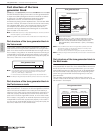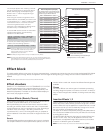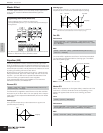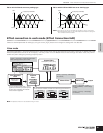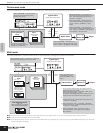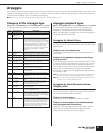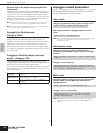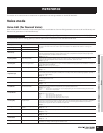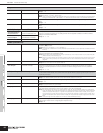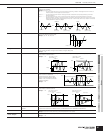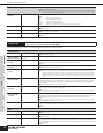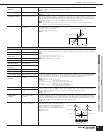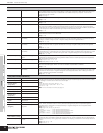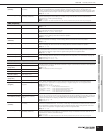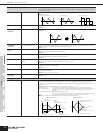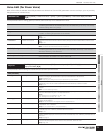
Owner’s Manual
Utility
Voice mode
Performance mode Multi mode Effect Arpeggio
Reference
Voice mode Voice Edit (for Normal Voice)
66
Output
Volume
Volume Determines the output level of the Voice.
Settings:0 ~ 127
Pan
Pan Determines the stereo pan position of the Voice.
Settings:L63 (far left) ~ C (center) ~ R63 (far right)
n When a stereo Voice is selected, this parameter setting may not be effective. Voices with Elements set to opposite Pan
settings (in the Element Edit → AMP display) – i.e., one at L63 and another at R63 – are considered stereo Voices.
RevSend
Reverb Send Determines the Send level of the signal sent from Insertion Effect 1/2 (or the bypassed signal) to the Reverb
Effect.
Settings:0 ~ 127
ChoSend
Chorus Send Determines the Send level of the signal sent from Insertion Effect 1/2 (or the bypassed signal) to the Chorus
Effect.
Settings:0 ~ 127
EG/FLT (Envelope Generator/Filter)
AEG Attack/Decay/
Sustain/Release
AEG Attack Time/Decay Time/
Sustain Level/Release Time
This display contains the basic EG settings, both volume and filter, for the Voice, as well as the filter’s cutoff
frequency and resonance settings. The settings made here are applied as offsets to the AEG and FEG
settings in the Element Edit mode.
Settings:-64 ~ 0 ~ +63
FEG Attack/Decay/
Release/Depth
FEG Attack Time/Decay
Time/Release Time/Depth
Cutoff/Resonance
Cutoff/Resonance
CtrlSet (Controller Set)
Set1-6ElmSw
Controller Set Element Switch Selects whether the controller will affect each individual Element. You can step through the Elements with
the BANK [E][F] buttons.
Settings:Elements 1 to 4 enabled (“1” to “4”) or disabled (“-“)
n This parameter is disabled when the Dest (Destination) described below is set to a parameter unrelated to the Voice
Elements.
Set1-6Source
Controller Set Source Determines which controller is to be assigned and used for the selected Set. This controller then is used to
control the parameter set in Destination below.
Settings:PB (Pitch Bend wheel), MW (Modulation wheel), AT (Aftertouch), FC1/FC2 (Foot controller 1/2), FS (Foot Switch), BC
(Breath controller), AS1/AS2 (Assign 1/2)
n Keep in mind that unlike the other controllers, Assign A and B can each be assigned to one common function for the
entire system of this synthesizer, and not to different functions for each individual Voice. Also see the Utility section
(page 90).
Set1-6Dest
Controller Set Destination Determines the parameter that is controlled by the Source controller (above).
Settings:Refer to the Controls List in the separate Data List.
Set1-6Depth
Controller Set Depth Determines the degree to which the Source controller affects the Destination parameter. For negative
values, the controller operation is reversed; maximum controller settings produce minimum parameter
changes.
Settings:-64 ~ 0 ~ +63
LFO (Low Frequency Oscillator)
This display gives you a comprehensive set of controls over the LFO for each individual Element. The LFO
can be used to create vibrato, wah, tremolo and other special effects, by applying it to the pitch, filter and
amplitude parameters.
Wave
LFO Wave Determines the LFO waveform used to vary the sound.
Settings:tri, tri+, sawup, sawdwn, squ1/4, squ1/3, squ, squ2/3, squ3/4, trpzp, S/H 1, S/H 2, user
Speed
Speed Sets the speed of the LFO waveform. A larger setting means a faster speed.
Settings:0 ~ 63
TempoSync
Tempo Synchronization Determines whether or not the LFO is synchronized to the tempo of the Arpeggio.
Settings:off (not synchronized), on (synchronized)
TempoSpeed
Tempo Speed This parameter is available only when TempoSync above has been set to “on.” It allows you to make detailed
note value settings that determine how the LFO pulses in sync with the Arpeggio.
Settings:16th, 8th/3 (eighth-note triplets), 16th. (dotted sixteenth notes), 8th, 4th/3 (quarter-note triplets), 8th. (dotted eighth
notes), 4th (quarter notes), 2nd/3 (half-note triplets), 4th. (dotted quarter notes), 2nd (half notes), whole/3 (whole-note
triplets), 2nd. (dotted half notes), 4th x 4 (quarter-note quadruplets; four quarter notes to the beat), 4th x 5 (quarter-
note quintuplets; five quarter notes to the beat), 4th x 6 (quarter-note sextuplets; six quarter notes to the beat), 4th x 7
(quarter-note septuplets; seven quarter notes to the beat), 4th x 8 (quarter-note octuplets; eight quarter notes to the
beat)
n The actual length of the note depends on the internal or external MIDI tempo setting.
RndSpdDpt
Random Speed Determines the degree to which the LFO speed changes at random. A setting of “0” results in the original
speed. Higher values result in a larger degree of speed change.
Settings:0-127



